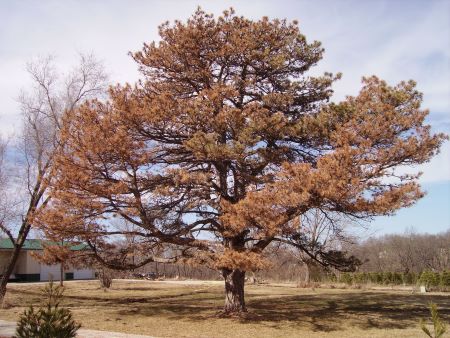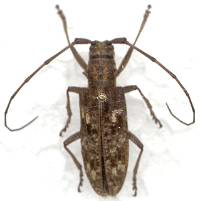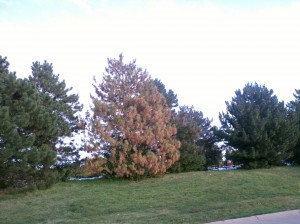Pine Wilt

This issue is a significant problem for a variety of mature pine trees across the state of Kansas. Pine Wilt is caused by the pinewood nematode (a microscopic worm) and affects Scotts, Austrian, white, and mugo pines in the eastern 2/3 of Kansas. The pine sawyer beetle carries the nematode from one tree to another. Female beetles lay their eggs under the bark of pine trees, usually during the summer, and the eggs hatch, then the larvae tunnel deep into the wood. While the larvae are maturing, the nematodes are also maturing. Just after the adult sawyer beetle breaks out of its pupal shell, large numbers of pinewood nematode larvae move into the new adult beetle's tracheae (breathing tubes). These nematodes are then carried to new host plants by the beetles.
While we call this "Pine Wilt," it is truly not a disease because the damage is caused by the nematode feeding and multiplying in the tree resin canals, which ultimately blocks the movement of food and water throughout the tree, leading to the wilting and death of the plant. In Kansas, the wilt infestations are most apparent from August through December, and infected trees can die over weeks or months, depending on the tree. The needles turn gray-green, yellow, and brown in the first stages. The change can happen branch by branch, or damage may occur throughout the entire plant. During the early stages, Pine wilt can be confused with tip blight (a fungal disease of pines that causes damage to the new growth of the pine tree. Damage shows up in late May or early June). However, tip blight has different symptoms and causes slow tree die-back over years rather than months. If you are concerned you have pine wilt, one way to check is by cutting a live or recently turned brown branch off the tree. For pines impacted by Pine wilt, there will be a decrease in the amount of resin since the nematodes feed on the resin canals. Once a tree has died, the needles will remain on the tree for up to a year. The unfortunate part of this issue is that it only impacts mature trees we have had for years.
feeding and multiplying in the tree resin canals, which ultimately blocks the movement of food and water throughout the tree, leading to the wilting and death of the plant. In Kansas, the wilt infestations are most apparent from August through December, and infected trees can die over weeks or months, depending on the tree. The needles turn gray-green, yellow, and brown in the first stages. The change can happen branch by branch, or damage may occur throughout the entire plant. During the early stages, Pine wilt can be confused with tip blight (a fungal disease of pines that causes damage to the new growth of the pine tree. Damage shows up in late May or early June). However, tip blight has different symptoms and causes slow tree die-back over years rather than months. If you are concerned you have pine wilt, one way to check is by cutting a live or recently turned brown branch off the tree. For pines impacted by Pine wilt, there will be a decrease in the amount of resin since the nematodes feed on the resin canals. Once a tree has died, the needles will remain on the tree for up to a year. The unfortunate part of this issue is that it only impacts mature trees we have had for years.
 The most crucial step to prevent the spread of Pine wilt is sanitation. If a tree is suspected of having Pine wilt or has died, try to get it cut down and removed by May 1st at the latest, preferably April 1st, to prevent the beetles from emerging and flying away. Be sure to cut the tree to the ground and do not leave a stump. The wood from the tree should be chipped or burned immediately. Don't save the wood for firewood, as the beetles will hatch from the wood. If possible, avoid stress on the tree as much as you can. During periods of drought, be sure to water the tree periodically to keep it healthy, as the beetles are attracted to stressed trees. If the nematodes haven't infested the tree, injections can be done to help prevent death from pine wilt. None of the treatments are 100% effective, and a professional must do them. Research is being done on possible cultivars of resistant pines at the John C. Pair Center in Haysville, so I hope that we will have some new evergreen options for windbreaks and landscape trees in the future. Currently, I would not recommend planting Scotts or Austrian pines in Kansas. Hopefully, we can plant pines again in the future, but for now, other evergreens are our only option.
The most crucial step to prevent the spread of Pine wilt is sanitation. If a tree is suspected of having Pine wilt or has died, try to get it cut down and removed by May 1st at the latest, preferably April 1st, to prevent the beetles from emerging and flying away. Be sure to cut the tree to the ground and do not leave a stump. The wood from the tree should be chipped or burned immediately. Don't save the wood for firewood, as the beetles will hatch from the wood. If possible, avoid stress on the tree as much as you can. During periods of drought, be sure to water the tree periodically to keep it healthy, as the beetles are attracted to stressed trees. If the nematodes haven't infested the tree, injections can be done to help prevent death from pine wilt. None of the treatments are 100% effective, and a professional must do them. Research is being done on possible cultivars of resistant pines at the John C. Pair Center in Haysville, so I hope that we will have some new evergreen options for windbreaks and landscape trees in the future. Currently, I would not recommend planting Scotts or Austrian pines in Kansas. Hopefully, we can plant pines again in the future, but for now, other evergreens are our only option.

Have questions? Contact our office where our Horticulture Extension Agent will assist you with questions.
Phone: (316) 321-9660
Email: callae@ksu.edu